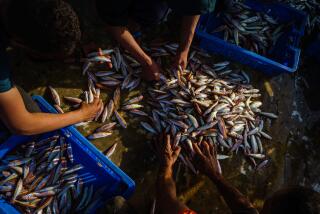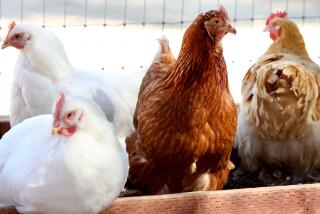Animals Are Victims of Vast Human-Regulated System of Slavery
- Share via
People are nervous and uncomfortable around things that they don’t easily understand. Sometimes, amid all the discussion that surrounds it, a new idea is either misunderstood completely or not understood at all. Such confusion surrounds the idea that non-human animals have rights. Many people think that this is either too ridiculous to be taken seriously or too complicated for anyone except philosophers. As usual, this kind of polarization disguises the much simpler truth of the matter: If human animals have rights, such as the right to life, so do non-human animals.
A common mistake, and a probable cause of much of the confusion, is the belief that human animals are radically different creatures from non-human animals. We are raised from childhood to see other animals as creatures that are in some way less than human and distinctly separate from us by nature. Most of us never even see animals, other than dogs and cats, except in pictures or zoos. Our separation is physical as well as mental.
We think about animals as objects whose purpose in the order of things is to serve human ends. We learn a whole set of unquestioned beliefs and a very specialized vocabulary that keep us from realizing the abuses that non-human animals undergo to satisfy these ends. A cow who has been killed, skinned, dismembered and ground up or sliced is “beef,” “leather,” “hindquarter,” “hamburger.” A laboratory rat is a “research tool” or “model.” A deer or a fox on a wildlife “refuge” becomes a “resource” deserving of “conservation.” Using these words, it is hard, if not impossible, to understand non-human animals as creatures that, like ourselves, experience pain and suffering and have complicated emotional lives.
Most of us know that what we do to animals we would never do to people. We understand that people have certain rights that keep them from being eaten, worn or experimented on by other people. What we don’t realize, until we really examine our beliefs about animals, is that these rights cannot belong exclusively to human beings. There is no non-arbitrary way to exclude such things as the right to life from non-human animals.
In order to continue to do what we have always done, we dream up excuses to hide the bolder truth. The excuses range from the unscientific “God gave them to us to use” to the pseudo-scientific “Animals are machines, not substantially different from clocks in their working.” These mind-boggling distortions prevent most of us from realizing that the human relationship with other animals is based on power. We are stronger than they are. We do whatever we want, whenever we want, because non-human animals are unable to stop us. In the same way in which people holding power deny the rights of people with less power, human animals deny the rights of non-human animals.
Animals are in laboratories because we are powerful enough to keep them there, not because it is where they belong. Once they are restrained and caged, we can burn, irradiate, infect, electrocute, poison and “sacrifice” them. The extent of experimentation is limited by imagination, not law.
Animals are on our dinner tables because we are powerful enough to control their lives from birth. We confine them in the smallest possible spaces, breed or artificially inseminate them, take their babies away from them, give them hormones, overfeed them and, finally, kill them. Animal skins, with and without their fur, are on our bodies because we are powerful enough to hunt, trap, club, shoot and harpoon other animals. We maintain wilderness habitats for fur-bearing animals in order to harvest them. We control the natural predator population to “conserve” the stock.
Animals are the victims of a vast human-regulated system of slavery. They serve our desires and whims, whether for the taste of their flesh, the feel of their skin or the profit that can be made. To see this enslavement for what it is, and to comprehend the suffering that it causes, is the first step toward understanding the meaning of animals’ rights--that is, the rights that are possessed by human and non-human animals alike. The next step is to respond to the call that this places on our conscience and do something to restore the rights that naturally belong to what Henry Beston called “other nations,” in a disturbing and beautiful passage in his book “The Outermost House.”






